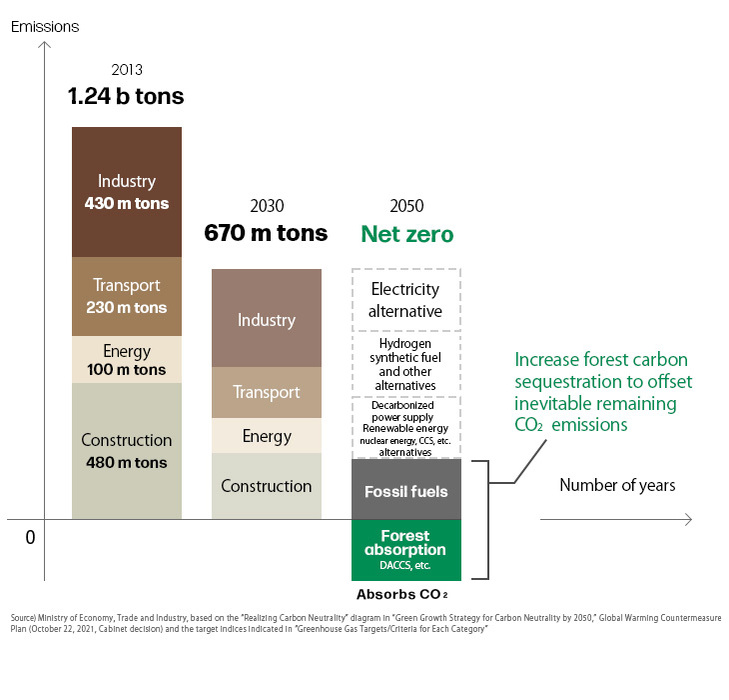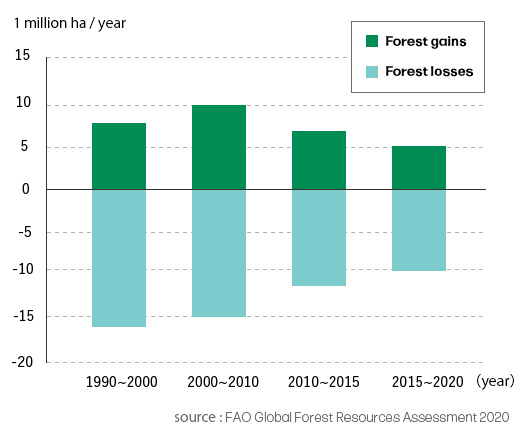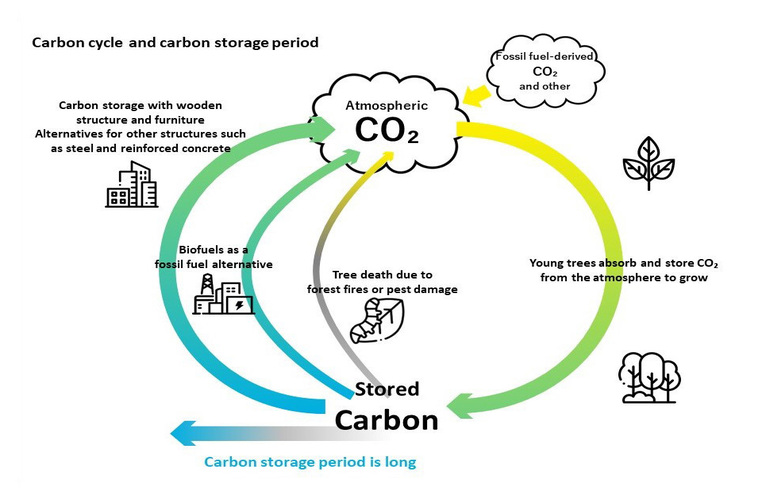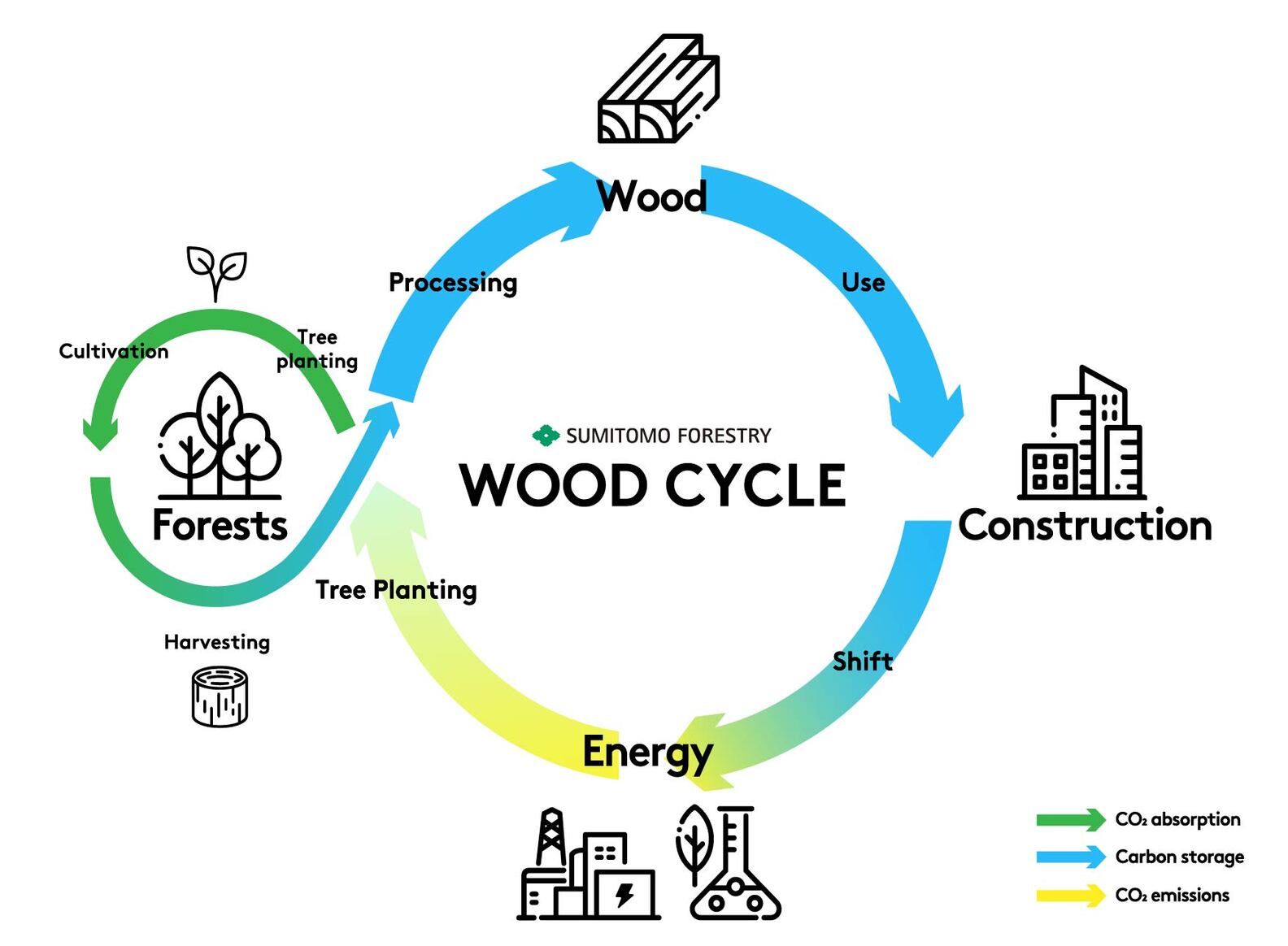In February 2022, the Sumitomo Forestry Group announced its long-term vision, "Mission TREEING 2030," which incorporates the Sumitomo Sumitomo Forestry Group's vision for decarbonized society into its long-term business plans, with an eye toward 2030, the target year for the SDGs.
Our mid-term management plan, "Mission TREEING 2030 Phase 2," began in 2025 and we are working towards achieving our long-term vision.
Overview of
Long-term vision
「Mission TREEING 2030」
Mission TREEING 2030
Making our planet safer and more secure for future generations
By providing value for the global environment, for people and society, and for the market economy, we at Sumitomo Forestry Group will strive to make our planet safer and more secure for current and future generations of people and all living beings. With our long-held strengths in harnessing and expanding the value of forests and wood, we will create change for a new future.
Three values and nine Material Issue
To realize our Long-Term Vision, we identified three values we want to provide – value for the global environment, value for people and society, and value for the market economy. We are committed to promoting business activities that simultaneously enhance all three values without sacrificing any of the other values..

Value for our planet
Material Issue 1
To enhance the value of forests and wood through sustainable forest management
By cultivating forests, we can increase and bring out the value of forest resources, including trees.
Material Issue 2
To realize carbon neutrality by leveraging forests and wood resources
In addition to reducing our own CO2 emissions, we contribute to the decarbonization of society by delivering "trees" that absorb and fix carbon, and by providing low-carbon and zero-carbon products and services.
Material Issue 3
To realize a circular bioeconomy by leveraging forests and wood resources
We aim to create a society in which all resources are recycled, while taking advantage of the strengths of wood, a material derived from forests that is renewable in the natural ecosystem.

Value to people and society
Material Issue 4
To provide comfortable and secure spaces for society at large.
We aim to provide a peace of mind and safety, comfortable and warm space to society at large.
Material Issue 5
To improve the livelihood of the local communities where we operate
Our business creates jobs and contributes to the development of the community.
Material Issue 6
To create a vibrant environment for all workers
We will create a workplace where everyone involved in our supply chain can work safely, healthily, and with enthusiasm.

Value to the market economy
Material Issue 7
To create new markets with forests and wood
By deepening and expanding the use of "forests" and "wood," we will create new markets and enrich the economy.
Material Issue 8
To transform markets through DX and innovation
We will increase economic efficiency and added value through market transformation, including digital transformation and innovation.
Material Issue 9
To establish a robust business structure
By building a system that is resilient even in the face of unforeseen circumstances and continuing to provide value, we will contribute to economic stability.
Business Policy
-
01
Maximizing the value of forests and wood to realize decarbonization and a circular bioeconomy
We will reduce operational carbon in all areas both domestically and overseas, promote the CO2 reduction effects of wood resources, and contribute to the decarbonization of society through our business.
visualization forests' CO2 absorption function and HWP*, revitalizing domestic forestry, and expanding medium- to large-scale wooden construction business, we will dramatically increase the value of timber resources and establish a circular bioeconomy centered on domestic timber.
* Harvested Wood Products
-
02
Advancing globalization
With business platforms in the United States, Australia and Asia at its core, the company will work to expand the group's business domain and scale overseas.
-
03
Striving for transformation and the creation of new value
The company aims to rebuild the revenue base of its domestic business through business transformation and innovation, including the promotion of digitalization.
-
04
Transforming our business foundation for growth
We will strive to continually secure, develop, and improve the engagement of human assets in response to the progress of globalization and diversification of our business, while also strengthening our risk management system.
Performance targets
Ordinary profit target for 2030: 350 billion yen
(revised upward in 2025)
Forests, a key element to realizing a decarbonized society
Increasing carbon sequestration capacity by forests is important to achieve carbon neutrality
Japan has set a goal of achieving "carbon neutrality" by reducing CO2 emissions to virtually zero by 2050. Even if we make every effort to reduce emissions, such as reducing the use of fossil fuels and switching to renewable energy, it will be difficult to achieve zero CO2 emissions. It is important to offset the remaining emissions by increasing carbon sequestration capacity by forests.


Increase CO2 absorption by cycling through the cycle of felling, sawing, timber and forestation
Around the world, large amounts of CO2 are being emitted due to forest fires, conversion to farmland, and other factors that cause deforestation, so it is important to protect forests. Meanwhile, in Japan, planted forest forestation after the war are reaching prime age for harvesting, and about half of them are over 50 years age of trees. As trees age, carbon sequestration capacity so it is important to cut them down and replant forestation to promote the rejuvenation of forests and increase carbon sequestration capacity.
Decreasing forest area of the world

Changes in carbon sequestration capacity due to age of trees

Utilizing wood for houses and other applications stores carbon for a long time.
Trees absorb CO2 from the atmosphere through photosynthesis and capture it as carbon. Even when trees are cut down and turned into lumber, the carbon remains stored. If wood is used for wooden constructions and furniture, the carbon is fixed for a long period of time and no CO2 is emitted. In addition, using scrap wood for biomass power generation can also be an alternative to fossil fuels.
Carbon cycle and carbon storage period

Sumitomo Forestry Group Initiatives
The Sumitomo Forestry Group's business activities are centered around "wood," from forest management to distribution, wooden constructions, and biomass power generation. This unique value chain is depicted in a diagram called the "wood cycle." By running this "wood cycle," we can contribute to decarbonized society by increasing carbon sequestration capacity by forests, promoting carbon storage in wood, and carbon storage over the long term in wooden constructions. Through this entire business, we will contribute to CO2 absorption and fixation not only for our own company, but for society as a whole.

Sumitomo Forestry 's Long-Term Vision
"Mission TREEING 2030"
Sumitomo Forestry Group has formulated the medium-term management plans "Mission TREEING 2030 Phase 1" and "Mission TREEING 2030 Phase 2" to achieve its long-term vision, "Mission TREEING 2030."

Long-term vision and medium-term management plan
(movie)
Towards decarbonization and biodiversity conservation
Forest fund formation presentation
(movie)
Mid-term Management Plan
"Mission TREEING 2030 Phase 2"
(movie)
Sustainability Report
Integrated Report
Annual Report











































